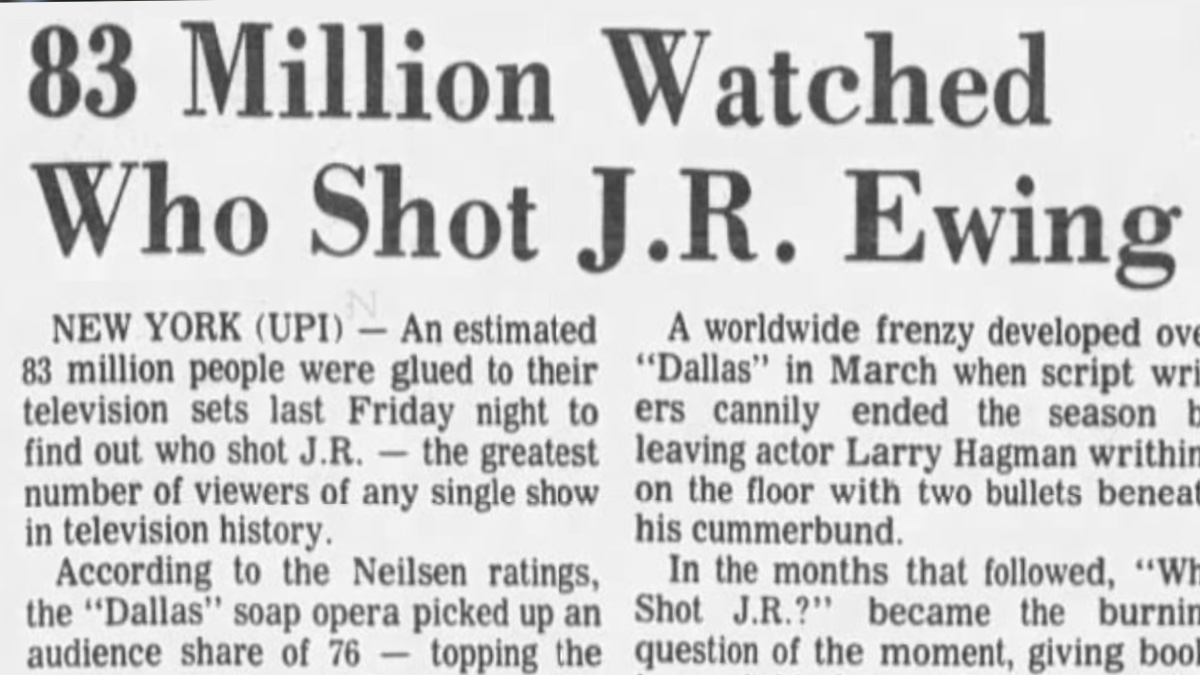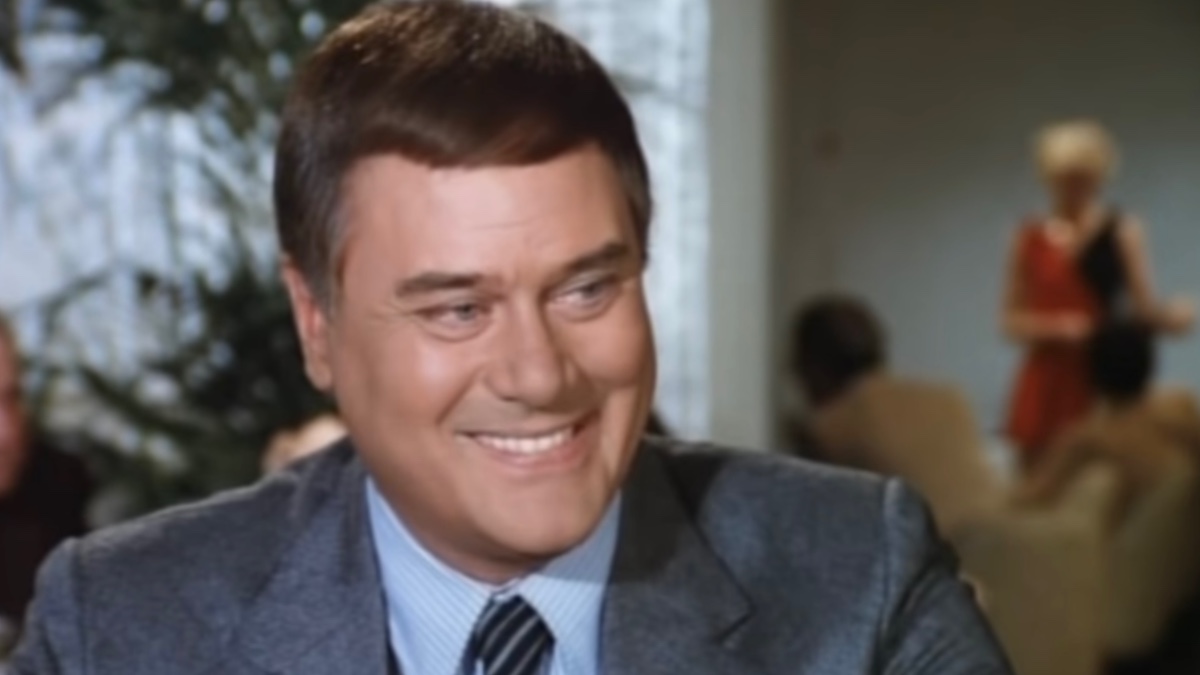There have been questions pondered in history that have been asked by the most inquisitive among us. Questions such as: To be or not to be? What is time? What is the meaning of life? And, of course….Who shot J.R.?
These are amongst the most popular questions ever asked and, although we don’t have answers for the first three, we do have an answer for that last one.
Perhaps no question in American pop culture history has experienced such a fever pitch like the above, which became more than just a question. It became a landmark moment in television history.
Here’s everything you ever wanted to know — or not know — about that question, including some wild tidbits and how it took over the country, as well as who actually did shoot J.R. Ewing, played by Larry Hagman, from the TV show Dallas.
Soap operas takeover primetime
In the early 1980’s, American television began to experience something of a primetime soap opera boom, thanks mostly to the series Dallas, which initially aired on CBS in 1978 as a five-part mini-series that was turned into a weekly show because of its higher-than-expected ratings.
Primetime soaps weren’t necessarily new, with Peyton Place being a popular example of such a show in the 1960’s, but such shows began to pop-up on every station after Dallas came along.
Oddly enough, the 1977 parody show called Soap may have helped reignite the popularity of soap operas in primetime. Soap was a nighttime show that basically made fun of the daytime soaps. Because of its success, perhaps CBS should not have been as surprised as they were when Dallas became a hit.
In fact, Dallas was such a hit that it spawned another soap opera called Knot’s Landing, which was a Dallas spin-off series. CBS then added Falcon Crest to their primetime soap lineup while ABC countered with Dynasty. There were even highly regarded soaps that didn’t last because of so much competition, such as NBC’s Flamingo Road. To say the early ’80s was a soap-filled era in primetime television is an understatement.
Dallas would last an impressive 13 years in its initial run, until 1991, and was later revived by TNT, who continued the series from 2012-14. Yet, it was in 1980 when Dallas peaked in popularity, unmatched by any show before it.
J.R. and the shot heard ‘round pop culture
Dallas initially featured J.R. Ewing (short for John Ross Ewing) in a supporting role, but his villainous ways earned him more screen time as fans loved to hate him. He was an oil tycoon who was a cunning, conniving, sneaky, selfish, and greedy businessman. He wouldn’t hesitate to backstab a friend, or family, for his own gain, and such an attitude meant that it was easy for him to make enemies. He even lied to get his wife sent to an asylum, bankrupted a friend, and set-up so-called business partners just to bring them down and make him look good while growing even richer than he already was. He cheated and lied his way to the top of that Dallas skyscraper, where his office overlooked the city.
The character was so despised by fans and fellow characters alike that, in 2013, TV Guide released a list of television’s “60 Nastiest Villains of All Time” and J.R. Ewing ranked #1.
At 10pm on the night of Mar. 21, 1980, and after a new episode of The Incredible Hulk and the Dukes of Hazzard, CBS aired the third season finale of Dallas. It was an episode titled “A House Divided.”
The final scene showed J.R. in his office at night, working practically in the dark with just a desk light on. He answers a phone call, but there is no voice on the other end, obviously made by someone to verify that he’s in his office. He gets coffee, walks back to his desk, looks out the window, and then is distracted by a noise. As he walks over to see who it is, he turns the corner and is shot twice in the abdomen. He falls to the ground and the episode ends without even a glimpse of the shooter.
Dallasmania in 1980
What’s lost in today’s re-telling of the finale is that CBS actually revealed earlier that week that J.R. would be shot in the final scene. Such an announcement was completely unnecessary, considering the popularity of the show, and critics thought revealing the end would spoil the episode. However, what CBS and Dallas showrunners understood is that J.R. Ewing was the most hated fictional character on television and a chance to see this corrupt villain finally get what fans felt he deserved would not be missed by many.
So, truth is that the “Who shot J.R.?” question was originally a “Who will shoot J.R.?” question. Newspapers dedicated entire columns to the episode before it even aired. Unsurprisingly, it was the most-watched TV episode of the week, with a 32.7 rating.
The insanity was already beginning, and no one cared that the shooting of J.R. was not fatal. It was expected that he would live because why would anyone kill off the most popular character on TV? Besides, most shows at the time did not end their seasons in such a way — with a major cliffhanger that so successfully captured the public’s interest.
For the rest of the spring and throughout the summer, Dallasmania took over. Merchandise was everywhere. “Who shot J.R.?” t-shirts were amongst the most popular items available, while hats, bumper stickers, and even “Who shot J.R.?” buttons proved to be hot items.
Then, there was a writer’s strike that lasted about a month and delayed the fourth season, though the delay only helped to build the anticipation, especially as those who felt left out of the craze were able to catch up with all the episodes CBS was forced to re-air in the meantime.
Finally, the fourth season kicked off, but fans would have to wait until the fourth episode for the reveal. It meant that the cliffhanger lasted for eight consecutive months, until the episode that finally answered pop culture’s most-asked question would be shown on Friday night, Nov. 21, 1980.
What are the odds?
For what is likely the most anticipated show in TV history, CBS sold one-minute commercial spots for a then unheard sum of half a million dollars.
Radio stations on the west coast announced that they would inform their audience who the culprit was immediately as it aired on the east coast, hours before the episode was to air in the west.
Air France announced that they would have an employee in New York watch the episode who would then relay what was happening to multiple flights who would could give updates to their passengers who were in-flight during the episode’s airing.

Las Vegas even put up odds on “Who shot J.R.?” with most people betting on his wife, Sue Ellen, or is wife’s former lover, Dusty Farlow.
Overall the odds were as follows, ranked by the most likely:
1 – Sue Ellen Ewing: J.R.’s wife was the favorite with even money odds.
2 – Dusty Farlow: Sue Ellen’s lover who was thought to be killed in an airplane crash was also even money.
3 – Vaughn Leland: J.R.’s former friend and now rival in the oil business whom he helped bankrupt had 3-to-1 odds.
4 – Kristin Shepard: J.R.’s mistress and sister-in-law (younger sister of Sue Ellen) was also 3-to-1 odds.
5 – Alan Beam: A lawyer who was effectively blacklisted by J.R. had 5-to-1 odds.
The odds continue with family members, such as his brother Bobby, but some fans believed that J.R. had himself shot in order to gain sympathy.
In order for the cast and crew to not be able to leak the answer to the question, the shooting scene was filmed several different times, each time with a different actor from the show so that every character was a possibility. J.R. Ewing was so disliked that Linda Gray, the actress who played his wife Sue Ellen, said, “I hope Sue Ellen did it. It would be the best part a woman got to play.”
Then the episode titled, “Who Done It?” finally aired on that Friday before Thanksgiving 1980.
Who shot J.R.?
So, who was it that shot the most hated character on TV?
It was Bing Crosby’s daughter, Mary Crosby. No, seriously. She played his mistress and sister-in-law Kristin Shepard on the show. Shepard set up Sue Ellen by using J.R.’s gun and planting it in Sue Ellen’s closet. Her motive? She had spied on J.R.’s business partners at his request but, despite his promises of a reward, he broke his promise, making it clear he had simply used her.
However, there was another reveal. As J.R. began to call the police on Kristin upon realizing her guilt, she said to him, “I wouldn’t do that if I were you. Not unless you want your child born in prison.”
That’s not the best way to get the news that you’re about to be a father but, all things considered, J.R. took it well. After thinking she was bluffing, he then hung up the phone and said he will deal with her in his own way.
And the saga continued.
The episode was a major success and it did indeed break TV records. 83 million people, one-third of the then-U.S. population, watched the reveal. The ratings were unprecedented. It was bigger than any Super Bowl up to that point and it broke the records held by the mini-series Roots, which had a 51.1 rating and 71% share in the 1977 finale of the mini-series. and also the record held by the monumental series finale of The Fugitive, which aired on Aug 29, 1967 and had 45.9 rating with 72% share.
The Dallas “Who done it?” episode had a 53.3 rating with 76% share, meaning that 76% of TV sets in the country tuned in to the show.

It was later estimated that 350 million people worldwide watched the finale.
As for what happened afterwards, well, just like any soap opera — it’s a long story. J.R. sent Kristin out of town, sending a monthly check for her. Not too long after she gave birth to their child, she was found dead in the swimming pool at Southfork Ranch, though there was not a “Who killed Kristin?” craze because she overdosed on drugs and fell into the pool.
Television would never be the same. No longer would most shows end their seasons with wrapping up all storylines. Instead, cliffhangers would come to define most season finales moving forward.
Because of the variety of streaming services available, which has helped change how we watch shows, it’s unlikely that such a major television event surrounding a show will ever get that many simultaneous viewers again.
Perhaps the most surprising example of its popularity is that here we are, more than 40 years later, and about 10,000 people a month Google “Who shot J.R.?”

